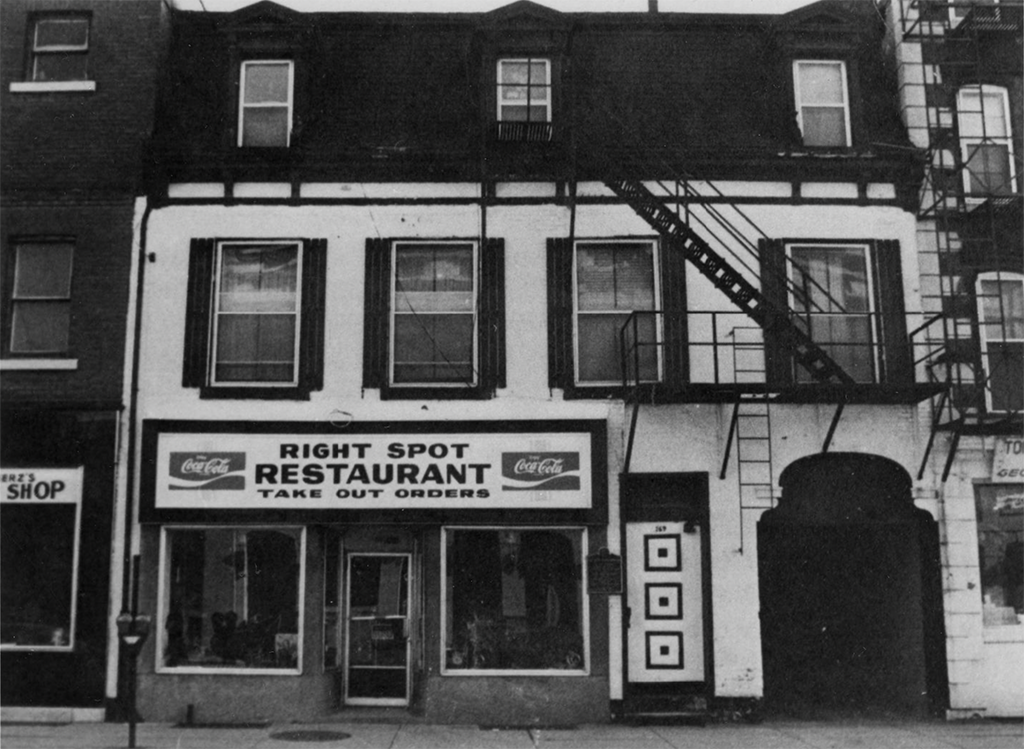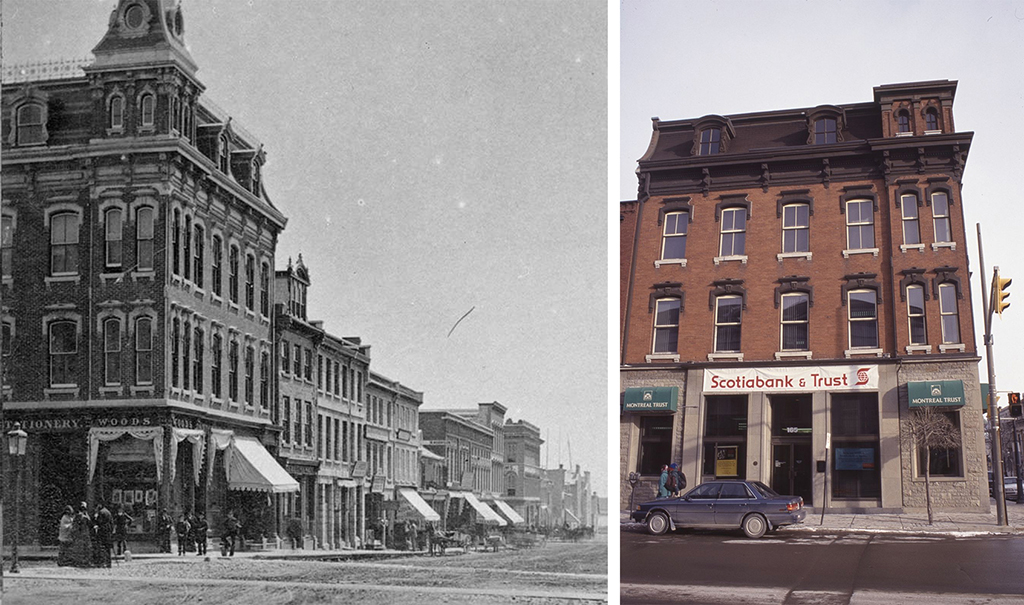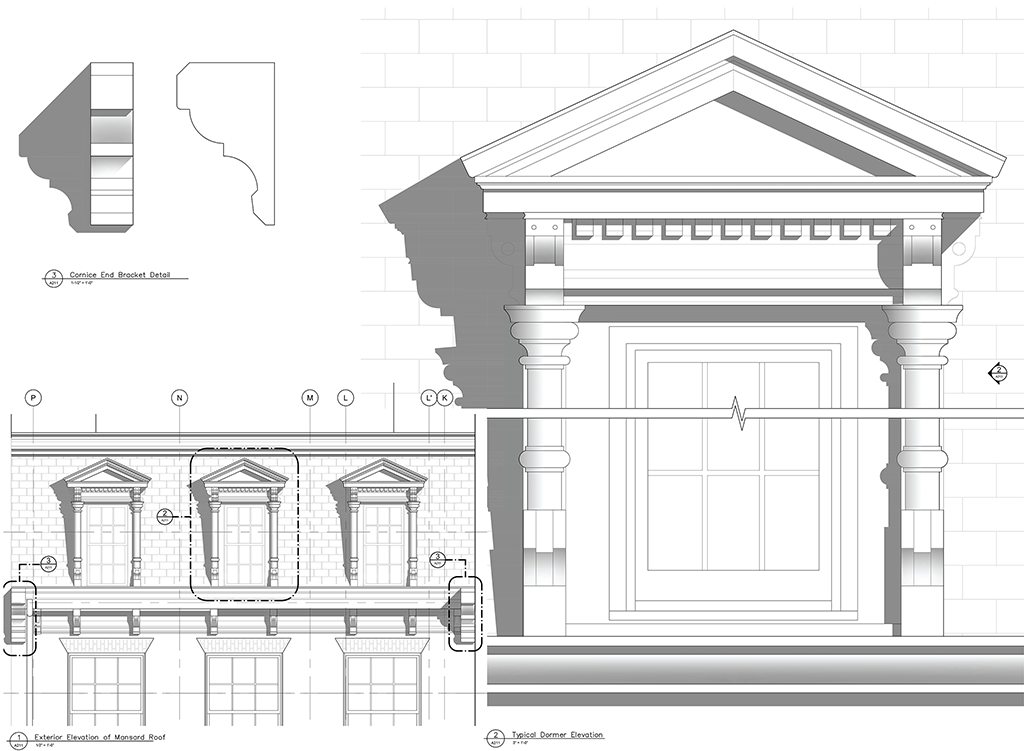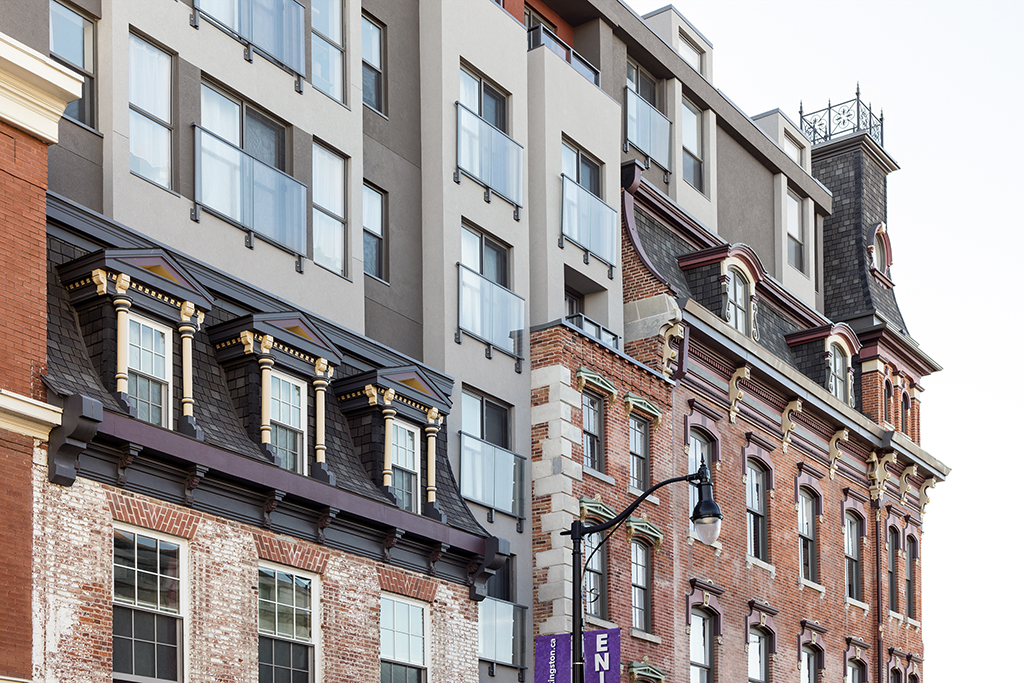Location: Kingston, Ontario
Completed: 1830s, 1870s, 2017
Architect: John Power and Sons (1876), Shoalts and Zaback Architects Ltd. (renovation)
Nominated by: Ted Hsu, MPP (Kingston and the Islands)
At the corner of Brock and Wellington Streets in Kingston’s historic downtown, you’d be forgiven for not immediately noticing a contemporary apartment building that was completed in 2017. Stitching together three historic buildings, the Kensington Apartments is a striking example of how historic preservation and increasing our housing supply can go hand in hand.
A Site Heavy with History
The site for the Kensington Apartments has a rich history, with an eclectic mix of buildings that are tied to both local landmarks and national stories. Prior to the introduction of the apartments, three distinct structures made up the site: a heritage-designated two-storey brick building with a mansard roof dating back to the 1830s, a quirky 1870s four-storey infill building that is only 12-feet wide, and a grandiose 1876 five-storey brick building designed by John Power and Sons, which also has heritage designation.
It is the two-storey building—which for many decades served as the popular “Right Spot Restaurant”—that has a historic connection to the founding of Canada. Here, Sir John A. Macdonald, Oliver Mowat, and Alexander Campbell founded their law practice, and it is this historic association, rather than architectural merit, that was the reason for its heritage designation.
 Historic image of the Right Spot Restaurant. Image courtesy of Queen's University Library Digital Collections.
Historic image of the Right Spot Restaurant. Image courtesy of Queen's University Library Digital Collections.
The tallest of the three buildings, designed in the Second Empire style, is located prominently at the corner of the block. Originally constructed to house a bank at its base and a masonic hall above, the building had undergone numerous renovations throughout its nearly 150-year history, including, at one point, the conversion of the masonic hall into offices for architects. Prior to the most recent conversion, the building had been empty for 15 years. Its iconic tower had also been partially lost, and much of the original architectural ornamentation had severely deteriorated.
 Left: 19th century image of 165 Wellington Street. Right: Later image of 165 Wellington Street, missing its tower. Images courtesy of Shoalts and Zaback Architects Ltd. (left) and Queen's University Library Digital Collections (right).
Left: 19th century image of 165 Wellington Street. Right: Later image of 165 Wellington Street, missing its tower. Images courtesy of Shoalts and Zaback Architects Ltd. (left) and Queen's University Library Digital Collections (right).
With a site so rich in history, it is no surprise that both city officials and local citizens were adamant about the retention of as much of the historic fabric as possible. This would be particularly challenging given the poor state of repair of the structures, but the developer, architect, and municipality all believed it would be a worthwhile endeavour to conserve and incorporate the existing facades into the new project.
Stitching Together a New Chapter
While there had been previous explorations for the site’s redevelopment—particularly of the five-storey building—the small footprint and full lot coverage had discouraged previous pursuits. While initial explorations included only the conversion of the corner building into apartments, the opportunity to consolidate all three properties into one site was critical in making the project financially feasible. But even with this increase in square footage, the undertaking would not come easy.
The buildings had faced years of neglect and were in poor state of repair. There was zero space for parking on the fully occupied lots. To complicate matters further, all three buildings had different floor levels and window heights—something that would have to be reconciled by the architect to make one continuous building. An additional storey would also be needed to make the project financially viable.
 Architectural drawing showing historic detailing. Drawing courtesy of Shoalts and Zaback Architects Ltd.
Architectural drawing showing historic detailing. Drawing courtesy of Shoalts and Zaback Architects Ltd.
Working with the municipality, the architect and developer were able to successfully waive parking minimums citing existing transit and the site’s downtown location. The different floor levels and window heights were transformed into a design opportunity, with each of the 26 apartments given unique layouts, including select multi-storey units, to blend the different buildings together. Elements like the historic tower and architectural ornamentation were reconstructed, and the retention of the historic facades maintained the historic rhythm and scale of the streetscape while providing spaces for commercial use.
New portions of the building were given their own contemporary architectural expression, allowing for clear differentiation of old and new while still echoing the bay pattern of the historic buildings below.
 Street-facing facade with elements of new and old. Image by Krista Jahnke Photography, courtesy of Shoalts and Zaback Architects Ltd.
Street-facing facade with elements of new and old. Image by Krista Jahnke Photography, courtesy of Shoalts and Zaback Architects Ltd.
Made possible thanks to a shared vision between an architect, a developer, and a municipality, the Kensington Apartments show that heritage retention and increasing housing supply are not conflicting goals This project not only revitalizes a significant historical site, but also sets a precedent for future developments to honour the past while meeting contemporary needs.
This post is part of the OAA’s Queen’s Park Picks 2024 series, where Ontario’s Members of Provincial Parliament (MPPs) were encouraged to nominate a building in their riding for a chance to learn more about it. This year, MPPs were asked to consider various typologies related to housing when making their suggestion, tying into the 2024 OAA Conference theme, Housing: Pushing the Envelope. Check out the rest of the series to learn more about great buildings across the province.